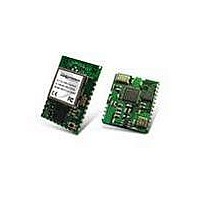WI.232FHSS-250-R Radiotronix, WI.232FHSS-250-R Datasheet - Page 29

WI.232FHSS-250-R
Manufacturer Part Number
WI.232FHSS-250-R
Description
RF Modules & Development Tools 900MHz FHSS Low
Manufacturer
Radiotronix
Datasheet
1.WI.232FHSS-25-FCC-RA-R.pdf
(67 pages)
Specifications of WI.232FHSS-250-R
Lead Free Status / RoHS Status
Lead free / RoHS Compliant
Other names
WI232FHSS-250-R
WI.232FHSS-25-R/ WI.232FHSS-250-R DATASHEET
3.6. Additional Module Pins
Additional module pins indicate the operational status of different functional blocks, or provide additional
control. There is no requirement that these pins be connected for normal operation, however they can
provide additional insight into the module. They may prove useful in the optimization of the end-
application.
3.6.1. Buffer Empty (BE)
The BE pin indicates the state of the incoming UART buffer. When the module receives data in the RxD pin,
and the CMD pin is high, the BE pin is lowered until all data in this buffer has been processed by the RF
engine. If acknowledgement is not enabled, the BE pin will be raised as soon as the RF engine processes
the outgoing packets. If acknowledgement is enabled, the buffer will not be updated until either the data
transmissions are acknowledged by the remote end, or the maximum number of retries has been exceeded.
When the BE pin returns high, the EX pin may be sampled, or the
determine if an error occurred during transmission.
3.6.2. Exception (EX)
The EX pin indicates whether a module exception has occurred. The pin is normally low. When an
exception occurs that passes masking (see
the
exception occurs before the
one.
3.6.3. RF Processing Incoming Packet (PROC_PKT)
Available on 250-R modules with firmware release 1.1.0 or later, the PROC_PKT pin indicates whether the
RF engine has determined there to be either valid or potentially valid data incoming. The line is normally low
(not processing). When awake and not transmitting, the RF engine is constantly searching for an incoming
signal. When scoring indicates that a potential packet is inbound, this line is raised until the scoring falls
below a given threshold or the complete packet is received. It is possible that the packet scoring will fall
below the PROC_PKT threshold during reception, causing the line to be lowered. Such an instance can
occur when the module hops to a channel late in the transmitter’s extended preamble. Since there aren’t a
large number of valid bits to score, the line may fall low during the packet start sequence. Once this
sequence arrives, the PROC_PKT signal will re-raise and latch for the duration of the packet reception.
3.6.4. Command Response (CMD_RSP)
The CMD_RSP pin is normally high. When the module’s command processor responds to a command,
such as a register read, the CMD_RSP pin lowers as the characters are transmitted out of the TxD pin.
Some host processors cannot react quickly enough to this signal, and may not able to separate the
command responses from incoming data. In this case, the
register controls the behavior of the TxD line when the CMD pin is low. If this register is set to 0x01 and the
CMD pin is low, the module stops the flow of incoming RF data to the TxD pin, internally buffering it. Once
the CMD pin is raised, the buffered incoming RF data resumes transport out the TxD pin.
regEXCEPTION
register is read, the exception is cleared and the EX pin will return low. If more than one
regEXCEPTION
Exception Engine section
register is read, the old exception will be overwritten by the new
28
regCMDHALT
regEXCEPTION
for details), the EX pin is raised. When
register may be of use. This
register polled to
Revision 1.1.0













